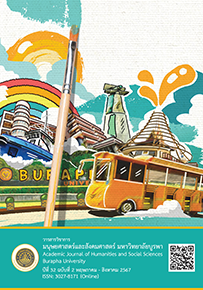The Dynamic and Retrial of Representation of Hae Pha Khuen That Tradition, Phra Maha That Varamahavihara Temple, Nakhon Si Thammarat
Main Article Content
Abstract
This article aims to analyze the dynamism and revival of meaning in the tradition of Stupa’s Fabric Tarpaulin-carrying Procession (Hae Pha Khuen That in Thai) performed in Wat Phra Maha That Temple, Nakhon Si Thammarat Province. The result is as follows – the tradition has been generally identified since the late 2520 B.E. by focusing on “fabric tarpaulins.” as mentioned in the Southern Thai Cultural Encyclopedia referring to the mythical legend of the great Buddha’s relic stupa of Nakhon Si Thammarat, a type of dedicative fabric tarpaulin in Buddhism is the so-called “Phra Bot,” an oblong painting cloth. After examining the primitive local narrative, however, some details are adapted to be matched with the provincial government’s description of Stupa’s Fabric Tarpaulin-carrying Procession even though it gets contradictory with the local meaning of the traditional Stupa’s Fabric Tarpaulin Celebration (Long Pha). Phra Bot cloths have not been discovered in Nakhon Si Thammarat Area since 1773 B.E. or earlier. The historical local rulers here seem to be only the establishment of reasonability for requesting tarpaulins from the royals.
Owing to academic expansion in Nakhon Si Thammarat Province itself in the 2510-2520 B.E., it is necessary to re-identify the tradition of Stupa’s Fabric Tarpaulin-carrying Procession by using academic evidence and methodology-the overlapping definition of Phra Bot cloths that dissolves the essence of folk narratives, so the local separately perform their own Stupa’s Fabric Tarpaulin Celebration to encounter the government’s activity and revise the meaning of tradition.
Downloads
Article Details

This work is licensed under a Creative Commons Attribution-NonCommercial-NoDerivatives 4.0 International License.
บทความทุกบทความเป็นลิขสิทธิ์ของวารสารวิชาการมนุษยศาสตร์และสังคมศาสตร์ มหาวิทยาลัยบูรพาเท่านั้น
References
กรมศิลปากร. (2560). ตำนานพระธาตุและตำนานเมืองนครศรีธรรมราช. กรมศิลปากร.
เฉลิม จิตรามาศ. (2566, 20 พฤศจิกายน). เจ้าหน้าที่ประชาสัมพันธ์ วัดพระมหาธาตุวรมหาวิหาร จังหวัดนครศรีธรรมราช. สัมภาษณ์.
ดิเรก พรตตะเสน. (2529). แห่ผ้าขึ้นธาตุ. ใน สุธิวงศ์ พงศ์ไพบูลย์ (บรรณาธิการ), สารานุกรมวัฒนธรรมภาคใต้ พ.ศ. 2529 เล่ม 10 (หน้า 4135-4136). สถาบันทักษิณคดีศึกษา มหาวิทยาลัยศรีนครินทรวิโรฒ สงขลา.
บัณฑิต ลิ่วชัยชาญ. (2560). คำชี้แจง. ใน บัณฑิต ลิ่วชัยชาญ (บรรณาธิการ), ตำนานพระธาตุและตำนานเมืองนครศรีธรรมราช (หน้า 6-20). กรมศิลปากร.
บานาน่าพลัส. (2566). นิทรรศการประเพณีแห่ผ้าพระบฏถวายพระบรมธาตุนครศรีธรรมราช. ป้ายนิทรรศการ.
พะเยาว์ ขำเกิด. (2566, 30 พฤศจิกายน). ชาวชุมชนหลังวัดพระมหาธาตุวรมหาวิหาร. สัมภาษณ์.
วิมล ดำศรี. (2557). ผ้าพระบฏพระราชทาน ปัจจัยและสื่อส่งเสริมสืบสานประเพณีแห่ผ้าขึ้นธาตุเมืองนครศรีธรรมราช. ศูนย์ศิลปวัฒนธรรม มหาวิทยาลัยราชภัฏนครศรีธรรมราช.
สุทธิวงศ์ พงศ์ไพบูลย์. (2529). คำชี้แจง. ใน สุทธิวงศ์ พงศ์ไพบูลย์ (บรรณาธิการ), สารานุกรมวัฒนธรรมภาคใต้ พ.ศ. 2529 เล่ม 10 (หน้า 7). สถาบันทักษิณคดีศึกษา มหาวิทยาลัยศรีนครินทรวิโรฒ สงขลา.
อาโด๊ด. (2566). เจดีย์ยักษ์กลางเมืองนครฯ สร้างโดยเศรษฐีมอญหงสาวดี. รามัญคดี - MON Studies. https://www.facebook.com/search/top?q=เจดีย์ยักษ์%20มอญ
อาหมัดอัลซารีย์ มูเก็ม. (2559). ประเพณี พิธีกรรม ความเชื่อ ที่มีความสัมพันธ์ต่อวิถีชีวิตของชนกลุ่มชาติพันธุ์เขมรบนพื้นที่บ้านจารย์ อำเภอสังขะ จังหวัดสุรินทร์. มหาวิทยาลัยธรรมศาสตร์.
องค์การบริหารส่วนจังหวัดนครศรีธรรมราช. (2530). มาฆบูชากวนข้าวมธุปายาส แห่ผ้าขึ้นธาตุ ถวายราชสักการ. แผ่นพับ.


